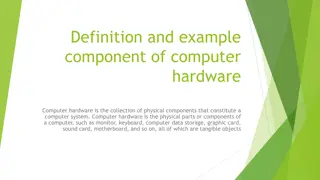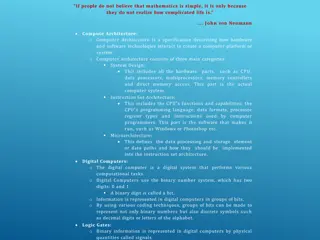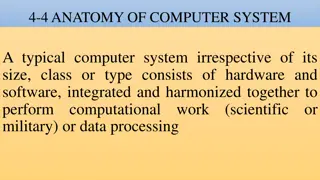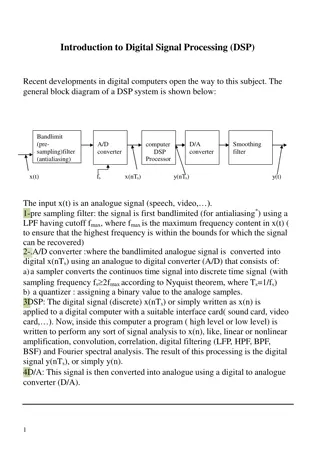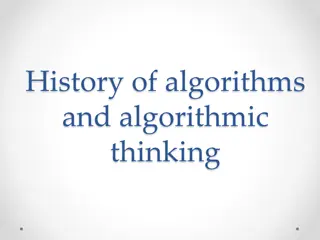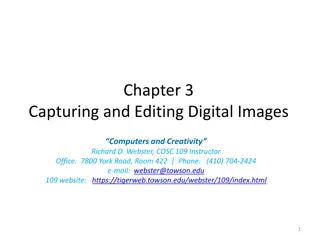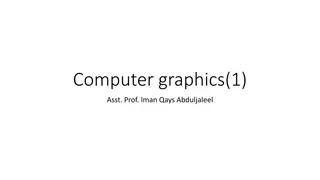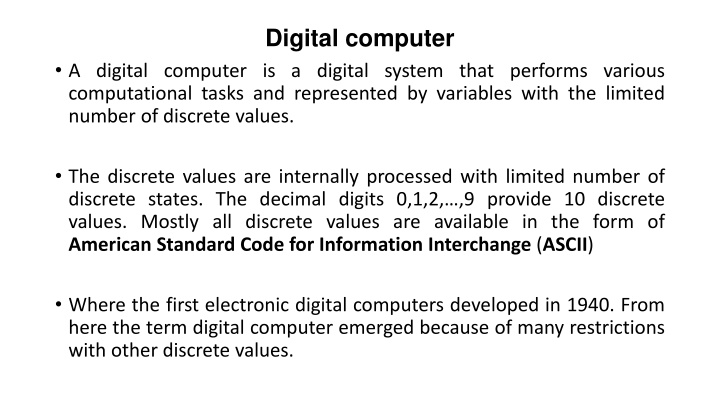
Overview of a Digital Computer System
A digital computer system performs computational tasks represented by variables with limited discrete values, processed internally with discrete states. The system includes hardware and software components, with hardware comprising electronic circuits, display units, and more, while software consists of instructions for data processing. Von Neumann architecture, proposed in 1945, introduced stored-program computers where programs and data are stored in memories. This architecture features the Central Processing Unit (CPU) with components like the Control Unit (CU) and Arithmetic and Logic Unit (ALU).
Download Presentation

Please find below an Image/Link to download the presentation.
The content on the website is provided AS IS for your information and personal use only. It may not be sold, licensed, or shared on other websites without obtaining consent from the author. If you encounter any issues during the download, it is possible that the publisher has removed the file from their server.
You are allowed to download the files provided on this website for personal or commercial use, subject to the condition that they are used lawfully. All files are the property of their respective owners.
The content on the website is provided AS IS for your information and personal use only. It may not be sold, licensed, or shared on other websites without obtaining consent from the author.
E N D
Presentation Transcript
Digital computer A digital computer is a digital system that performs various computational tasks and represented by variables with the limited number of discrete values. The discrete values are internally processed with limited number of discrete states. The decimal digits 0,1,2, ,9 provide 10 discrete values. Mostly all discrete values are available in the form of American Standard Code for Information Interchange (ASCII) Where the first electronic digital computers developed in 1940. From here the term digital computer emerged because of many restrictions with other discrete values.
Functional Units of Computer System Functional Units of Computer System It is divided in two modules in general: Hardware: A hardware of the computer system consists of all electronic components such as electronic circuits, display units, storage media (magnetic and optical (a class of data storage systems that use light to read or write data to an underlying optical media-CD, DVD)), electromechanical devices and communication facilities. Software: It consists of the instructions and data that the computer manipulates to perform various data-processing tasks. Where sequence of instruction is called a program.
Von Neumann Architecture Von-Neumann computer architecture design was proposed in 1945. It was later known as Von-Neumann architecture. Historically there have been 2 types of Computers: 1. Fixed Program Computers Their function is very specific and they couldn t be reprogrammed, e.g. Calculators. 2. Stored Program Computers These can be programmed to carry out many different tasks, applications are stored on them, hence the name is.
Von Neumann architecture Contd Modern computers are based on a stored-program concept introduced by John Von Neumann. In programs and data are stored in a separate storage unit called memories and are treated the same. this stored-program concept, This novel idea meant that a computer built with this architecture would be much easier to reprogram.
Von Neumann architecture is also known as ISA (Instruction set architecture) computer and is having three basic units: Memory Unit and Input/Output Unit. Central Processing Unit (CPU), Main 1. Central Processing Unit- The central processing unit is defined as an electric circuit used for the executing the instruction of computer program. It has following major components: 1.Control Unit(CU) 2.Arithmetic and Logic Unit(ALU) 3.variety of Registers Control Unit A control unit (CU) handles all processor control signals. It directs all input and output flow, fetches code for instructions, and controls how data moves around the system. Arithmetic and Logic Unit (ALU) The arithmetic logic unit is that part of the CPU that handles all the calculations the CPU may need, e.g. Addition, Subtraction, Comparisons. It performs Logical Operations, Bit Shifting Operations, and Arithmetic operations.
Registers Registers 1.Registers Registers refer to high-speed storage areas in the CPU. The data processed by the CPU are fetched from the registers. There are different types of registers used in architecture :-Accumulator: Stores the results of calculations made by ALU. It holds the intermediate of arithmetic and logical operatoins.it act as a temporary storage location or device. 2.Program Counter (PC): Keeps track of the memory location of the next instructions to be dealt with. The PC then passes this next address to the Memory Address Register (MAR). 3.Memory Address Register (MAR): It stores the memory locations of instructions that need to be fetched from memory or stored in memory. 4.Memory Data Register (MDR): It stores data fetched from memory or any data that is to be transferred to, and stored in, memory. 5.Current Instruction Register (CIR): It stores the most recently fetched instructions while it is waiting to be coded and executed. 6.Instruction Buffer Register (IBR): The instruction that is not to be executed immediately is placed in the instruction buffer register IBR.
Input and Output Unit Input and Output Unit Input: Computer accept coded information through input unit. The most common device is Keyboard. Whenever key is pressed, the corresponding letter or digit is automatically translated into its corresponding binary code and transmitted over a cable to either memory or the processor. Output: The output unit is the counterpart of the input unit. Its function is to send processed results to the outside world. The most familiar device is a printer. Some units, such as graphical displays, provide both an input and output function.
Memory Memory The function of the memory unit is to store programs and data. There are two classes of storage, called as Primary and Secondary. Primary storage is a fast memory. The memory contains large number of semiconductor storage cells, each cell capable of one bit of information. These cells are rarely used as an individual cell instead are processed in group of fixed size, called words. To provide an easy access of any word in memory, a distinguished address is associated with each word location. Addresses are numbers that identify successive locations. The typical word lengths range from 16 to 64 bits. Memory in which any location can be accessed in short and fixed amount of time after specifying address is called Random Access Memory (RAM). CPU is known as RAM because CPU can access any locations at any point of time.
Memory Cond The smaller and fasted unit is called Cache. The largest and slowest unit is referred to as main memory. Although primary storage is essentials and expensive. But in addition to the same cheaper memory is available as a secondary memory storage, where large amount of data and many programs may be stored. A wide range of secondary storage are available in the form of magnetic disks, tapes and opticals disks (CD-ROMS).
Memory unit The computer memory is measured in terms of bits, bytes and words. A bit is a binary digit either 0 or 1. A byte is unit of memory and is defined as sequence of 8 bits. The word can be defined as a sequence of 16/32/64 bits or 2/4/8 bytes respectively depending on the machine architecture 12
Primary storage: RAM & ROM RAM stands for Random Access Memory Read and write memory Information typed by the user are stored in this memory Any memory location can be accessed directly without scanning it sequentially (random access memory) During power failure the information stored in it will be erased volatile memory ROM stands for Read Only Memory Permanent memory and non volatile Contents in locations in ROM can not be changed Stores mainly stored program and basic input output system programs 13
Secondary memory Main memory is volatile and limited Hence it is essential for other types of storage devices where programs and data can be stored when they are no longer being processed Installed within the computer at the factory or added later as needed 14
Secondary memory Non-volatile memory Made up of magnetic material Stores large amount of information for long time Low speed Holds programs not currently being executed 15
Cache memory High speed memory placed between CPU and main memory Stores data and instructions currently to be executed More costlier but less capacity than main memory Users can not access this memory 16
Buses Data is transmitted from one part of a computer to another, connecting all major internal components to the CPU and memory. Types: Data Bus: It carries data among the memory unit, the I/O devices, and the processor. Address Bus: It carries the address of data (not the actual data) between memory and processor. Control Bus: It carries control commands from the CPU (and status signals from other devices) in order to control and coordinate all the activities within the computer.
High level Programming Languages In computer science, a high-level programming language is a programming language with strong abstraction from the details of the computer. In contrast to low-level programming languages, it may use natural language elements, be easier to use, or may automate (or even hide entirely) significant areas of computing systems (e.g. memory management), making the process of developing a program simpler and more understandable than when using a lower-level language. The amount of abstraction defines how "high-level" a programming language is provided.
Difference between High Level and Low level languages Both High level language and low level language are the programming languages s types. The main difference between high level language and low level language is that programmers can easily understand or interpret or compile the high level language in comparison of machine. On the other hand, Machine can easily understand the low level language in comparison of human beings. Examples of high level languages are C, C++, Java, Python, etc.
Difference between High Level and Low-level language High Level Language Low-level language 1. It is programmer friendly language. It is a machine friendly language. 2. High level language is less memory efficient. Low level language is high memory efficient. 3. It is easy to understand. It is tough to understand. 4. Debugging is easy. Debugging is complex comparatively. 5. It is simple to maintain. It is complex to maintain comparatively. 6. It is portable. It is non-portable. 7. It can run on any platform. It is machine-dependent. It needs compiler or interpreter for translation. 8. It needs assembler for translation. 9. It is used widely for programming. It is not commonly used now-a-days in programming.
Compiler Compiler A Translator (compiler) is a program that reads a program written in one language, the source language, - and translate it into an equivalent program in another language, the target language. In program that translates computer code written in one programming language (the source language) (the target language). computing, a is a computer compiler into another language The name "compiler" is primarily used for programs that translate source code from a high-level programming language to a low-level programming language (e.g. assembly language, object code, or machine code) to create an executable program
Assembly Language Assembly Language is a low-level programming language. It helps in understanding the programming language of machine code. Machine code is a series of instructions that provide the necessary information to a user s CPU to carry out a particular task (add, subtract, compare values, etc.). In computers, there is an assembler that helps in converting the assembly code into machine code executable. It establishes with the help of compiling high-level language source code like C and C++. It mainly depends on the system architecture, whether it is an operating system or computer architecture to add assembler?






